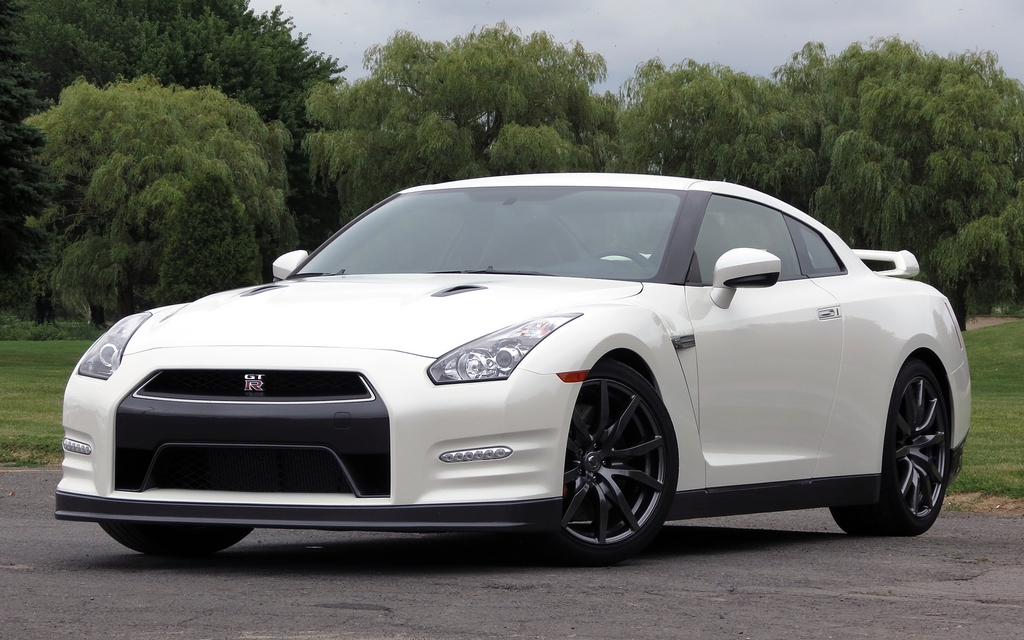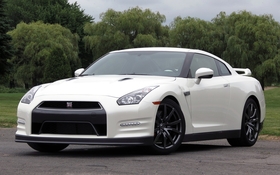2013 Nissan GT-R: Four days in the Batmobile

| Strong points |
|
|---|---|
| Weak points |
|
Like the shark in Jaws or the Tyrannosaurus Rex in Jurassic Park, the threat that the GT-R presented for elite western sports cars came long before the production version of the beast actually appeared at the 2007 Tokyo Auto Show – and without the sound effects. This threat became evident with the unveiling of prototypes in 2001 and 2005, but more significantly, with the publication of the impressive technical data sheet for this new land rocket from Nissan.
The versions of the GT-R, which were seriously souped up versions of the Japanese Skyline, were already mythical cars for enthusiasts and driving simulation gamers (Gran Turismo comes to mind). The championships and records collected by the R32, R33 and R34 confirmed it unequivocally. Moreover, this new R35 GT-R set not only the best Japanese sports cars in its sights, but the best sports cars on the planet too. And for the first time it was built on its own platform (unlike the Skyline, which used the FM – known in Canada as the Infiniti G37—architecture).
Hidden horsepower and missed opportunities
Under the hood of the new GT-R is a 3.8-litre twin-turbo V6 topped with a silver and red intake manifold. Nissan rather modestly announced 480 horsepower, but it easily transmits more than 500 horses to all four wheels using an ultra-refined electronic AWD system. The GT-R promised performance and handling for a predictable price.
But the anticipated massacre of the competition never came to pass. The GT-R clocked impressive times and won several battles, but it didn’t win the war. It also missed several important opportunities, at least in the eyes of Car Guide readers. First, it missed the sports car match-up for the 2009 edition of Le Guide de l’auto because it was banned from the track. More recently, it missed the 2013 edition because the 2013 model-year GT-R wasn’t ready in time.
I was fortunate enough to do dozens of laps on a marked course in the first GT-R at AJAC’s annual testing, which was enough for me to discover its peerless efficiency and intensity. Fast, direct and exciting like no other. Almost brutal, in fact. I learned during the shooting of the Le Guide de l’auto television show at the Saint-Eustache circuit that it’s less comfortable in long turns where it understeers noticeably if you give it too much gas.
The GT-R’s feats on the circuit led me (the driving diehard that I am) to forgive its lack of manners, the loud noises from its gearbox and the barely tolerable firmness of its suspension. More objectively, the auto journalist in me could only conclude that this mechanical beast is definitely not for everyone.
Never satisfied
The engineers and designers didn’t sit on their laurels after launching the first GT-R: they have updated it several times since. Its official engine power has gone from 485 horses to 530 last year and finally to 545 for the 2013 version, which has been on the market since spring. The price also quickly climbed from $80,000 to more than $100,000. The price of the Black Edition is a whopping $113,380.
The suspension, transmission, and brakes have been modified to improve performance and make the vehicle more civilized, while the body has been touched up to improve cooling and aerodynamics without changing its shape. Despite these updates, the GT-R has kept its razor-sharp lines, its gaping front grille, its four big, round brake lights and its foursome of bazooka-sized exhausts.
Since we were unable to test the GT-R for the Le Guide de l’auto 2013’s sports car comparison, we jumped at the chance to drive for a four-day test drive. However, we had to promise the dealership that loaned it to us that we wouldn’t drive it on a circuit. Thus, I can’t comment on its handling when pushed to the limit of its tire grip, but I have no doubt that the GT-R’s cold savagery is just as good, if not better.
Sprint records
I eagerly jumped inside the white GT-R with my VBox to measure its performance. The goal was not only to see the effect of the 60 additional horses, but also to test the new launch control mode that Nissan has named R Mode and has clearly explained in its manual. It’s fairly simple: put the shifter and VDC in R mode, put the left foot on the brake, press the accelerator down all the way while the rev counter climbs to 4,000 rpm, release the brake and the GT-R pounces as the rear wheels skid just enough.
Wow, this time it works right off the bat, which wasn’t the case with the first GT-R. The first two tries were successful, but the on the third try, the power completely cut just after the start. A message on the dashboard announced that the clutches were overheating and that I have to let the things cool off. I had been warned. It was mentioned in the manual. So, I eased off and let this complex machinery overflowing with electronic controls breathe.
A few minutes later, the GT-R took on two more ¼ miles, and the numbers were even better. In fact, they were the best times that we recorded that day: a 0-100 km/hr in 3.33 seconds and the quarter mile in 11.41 seconds. That’s better than the 3.80 and 11.75 times for the Porsche 911 Turbo, which is still faster at the end of the quarter mile with a maximum speed of 199.9 km/hr versus 198.3 km/hr for the GT-R. My best results with the first GT-R were 3.85 and 12.00 seconds and 193.0 km/hr, respectively.
I should specify that these numbers do not take into account the one-foot rollout that simulates timing in a drag race where the first foot of the race doesn’t count. The difference can range from 2 to 4 tenths of a second. When braking, the GT-R came to a stop at 100 km/hr in 35.0 metres even, compared to 34.82 for the 911 Turbo.
The impatience of a thoroughbred
In normal conditions, the GT-R seemed to me like a civilian version of the Batmobile, at least in terms of style (minus the rocket launchers, of course). That’s what I was thinking as I left the movie theatre after seeing the summer blockbuster. It even looked docile and harmless in white, but I eventually stopped counting the turned heads, the approving waves and the telephones and cameras pointed at it. Even on the highway.
At a stop or at slow speeds on smooth roads, the GT-R is very well behaved, but that never lasts long. As soon as you accelerate, even a little, the beast awakens and finds it tough to control its power. Not unlike the Hulk just before his shirt rips off him.
Even if you systematically set the Bilstein dampers in comfort mode, the ride is firm and the jolt is intense as you hit the slightest crack in the road. With its large tires, the GT-R also reacts to ruts and follows the profile of the asphalt like no other car out there. With its lively, taut steering, you’ll have to pay constant attention to stay on course. For the driver, the seat, ergonomics and controls are impeccable. Same goes for the steering wheel (which only adjusts up and down) and the pod that houses several superb gauges.
Out for a leisurely ride, I chose to drive slowly because the muffled sound of the four big exhausts frankly becomes intolerable with two people in the car. I would have gladly pushed a button to cut this drone by half, unlike what you’d say about some German rivals. The police patrolman seemed intrigued – or depressed – in his Charger to see me go by at a mere 100 km/hr on the highway in a car like that. At least this pace helped lower fuel consumption to 10.93 L/100 km on my usual route.
Big challenges ahead
As a grand tourer, you can easily find better than the GT-R. I would have really liked to see how it would have done head-to-head in our comparison with the Porsche 911 Carrera S, Audi TT RS and Mercedes-Benz SL 550. There’s no doubt it would have been insane on the ICAR circuit, but it would have been absolutely mind-blowing on our several hundred kilometre road loop.
You can bet your bottom dollar that the next Porsche 911 Turbo will take back its acceleration records and that the production version of the spectacular Acura NSX will grab the title of best Japanese sports car, price for price, from the GT-R. This much is certain: the engineers at Nissan will have to outdo themselves for the next one to live up to its reputation and to satisfy its cult following. Plus, they’ll have to make it more fuel efficient and refined, like its best rivals. Otherwise, it faces extinction like the good old mutant T-Rex that gave it its fearsome nickname: Godzilla.
That said, there would definitely be a GT-R in my dream garage, given its incomparable ferocity on the circuit – as long as it’s not the only sports car that I’m allowed to have.






